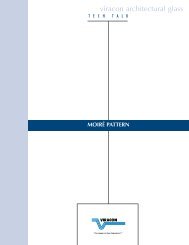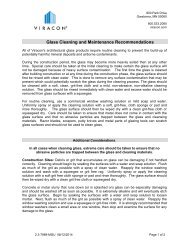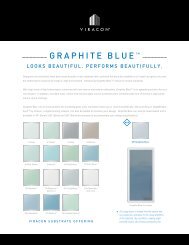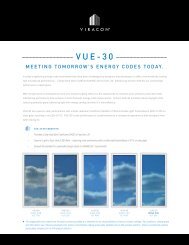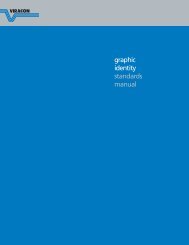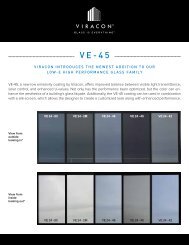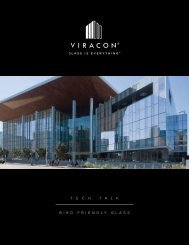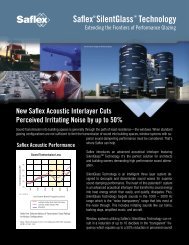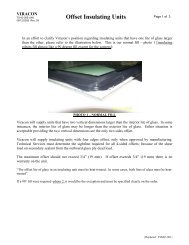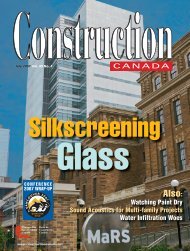2 0 1 3 P R O D U C T G U I D E VIRACON PRODUCT GUIDE 2013 ...
2 0 1 3 P R O D U C T G U I D E VIRACON PRODUCT GUIDE 2013 ...
2 0 1 3 P R O D U C T G U I D E VIRACON PRODUCT GUIDE 2013 ...
Create successful ePaper yourself
Turn your PDF publications into a flip-book with our unique Google optimized e-Paper software.
GLOSSARY<br />
Roller Wave: The appearance of waviness sometimes seen in heat treated glass caused by the glass moving over rollers in<br />
the tempering furnace.<br />
Sandblasted Finish: A surface treatment for flat glass obtained by spraying the glass with hard particles to roughen the<br />
surface. The method restricts vision while maintaining a level of light transmission.<br />
Setting Blocks: Generally rectangular, cured extrusions on which the glass product bottom edge is placed to effectively<br />
support the weight of the glass. Viracon recommends that only 100% silicone setting blocks be used for all types of glazing systems.<br />
Shading Coefficient: Shading coefficient is the ratio of solar heat gain through a specific type of glass that is relative to<br />
the solar heat gain through a 1/8”” (3mm) ply of clear glass under identical conditions. As the shading coefficient number<br />
decreases heat gain is reduced which means a better performing product.<br />
Sightline for Insulating Glass: Edge dimension of insulating glass covered by spacer and intended to be covered in glazing channel.<br />
Silk-screen: A process of applying a specific design or pattern to glass. The design is made by placing a screen over a piece<br />
of glass and then pressing ceramic frit by means of a large squeegee through the pores of the screen. After the frit is applied<br />
the glass goes through an infrared oven to dry the frit and then through a tempering furnace to fire (bond) the frit to the glass<br />
permanently.<br />
Skylight: A window glazed in a roof or ceiling of a building.<br />
Sloped Glazing: Glass units that are glazed more than 15° off vertical.<br />
Solar Control Glass: Tinted and/or coated glass that reduces the amount of solar heat gain transmitted through a glazing product.<br />
Solar Energy: The sum total of the solar spectrum.<br />
Solar Heat Gain Coefficient (SHGC): The portion of directly transmitted and absorbed solar energy that enters into the<br />
building’s interior. The higher the SHGC the higher the heat gain.<br />
Solar Reflectance: The percentage of solar energy that is reflected from the glass surface(s).<br />
Solar Reflective Coatings: Coatings that reduce heat gain through higher solar reflection.<br />
Solar Spectrum: The solar spectrum commonly referred to as sunlight consists of ultraviolet light (UV) visible light and infrared<br />
(IR). The energy distribution within the solar spectrum is approximately 2 percent UV 47 percent visible light and 51 percent IR.<br />
Solar Transmittance: The percentage of ultraviolet visible and near infrared energy (300 - 3000 nanometers) that is<br />
transmitted through the glass.<br />
Spandrel: The panel(s) of a wall located between vision areas of windows which conceal structural columns floors and shear walls.<br />
Stc Rating: Sound Transmission Class Rating is a single-number rating system for interior building partitions and viewing<br />
windows used to categorize acoustic performance. Its original intent was to quantify interior building partitions not exterior<br />
wall components. As a result it is not recommended for glass selection of exterior wall applications since the single-number<br />
rating was achieved under a specific set of laboratory conditions.<br />
Structural Silicone Glazing: The use of a silicone sealant for the structural transfer of loads from the glass to its perimeter<br />
support system and retention of the glass in the opening.<br />
Substrate: The raw glass or base material to which other materials or fabrication procedures are applied.<br />
Tin Side: The bottom side of float glass as it was manufactured called “tin side” because float glass rides on a bath of liquid<br />
tin while it is being cooled.<br />
U-Value: A measure of heat gain or heat loss through glass due to the thermal conductance and the difference in indoor and<br />
outdoor temperatures. As the u-value decreases, so does the amount of heat that is transferred through the glazing material.<br />
The lower the u-value the more restrictive the fenestration product is to heat transfer; reciprocal of r-value.<br />
132<br />
<strong>VIRACON</strong> // RESOURCES



